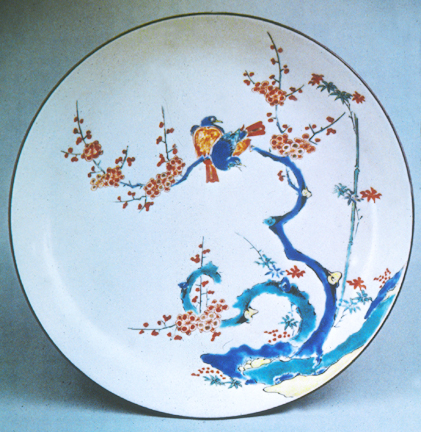Porcelain did not make an appearance in Japan until the early 1600's, centuries after it was first made in China. During the Ming Dynasty, large amounts of porcelain were imported into Japan, and potters attempted to reproduce this ware, but they were unsuccessful until an immigrant potter, Ri Sampei, who would settle in the Arita district, on the southernmost island of Kyushu, near Korea, began porcelain production. The Japanese Emperor, Hideyoshi, had extended Japanese control into Korea around 1590, and while there is some controversy over whether the relocations were voluntary or forced, many Korean potters and their families were brought back to settle in Japan in what came to be called the Pottery Wars. One of these potters was Ri Sampei, who found a usuable white kaolin clay near Arita in 1616 and began producing porcelain in the Korean style. His success in producing porcelain created quite a stir, and set off a blizzard of imitators in Arita, and soon over 40 kilns were in production there, causing extreme shortages of forest wood and clay as well. An edict was issued protecting the Korean potters by banning over 800 Japanese residents from working at the kilns. The earliest Arita porcelains strongly resembled their Yi dynasty counterparts in Korea, and were simply painted in underglaze cobalt. Little of this work survives since most of it was domestic ware.
Within 50 years, another Korean immigrant potter, Sakaida Kakiemon,
would recreate another Chinese secret: the overglaze enamel technique employed
by Ming potters. A wealthy Japanese merchant imported large quantities of
overglaze work, and provided Kakiemon with examples to study. He also would
'observe closely' the techniques he saw on his frequent buying trips to
Jingdezhen. He shared his observations with Kakiemon, and it did not take
long for him to replicate the effect. Kakiemon feared that his discovery
would be stolen as well, so would only reveal the secret to his eldest son,
sending his second and third sons into adoption to safeguard the secret.
All to no avail, as during his own lifetime, other potters in Arita also
experimented and learned how to overglaze porcelain.
Characteristic of Kakiemon ware is a pure white porcelain body, onto which are painted bright colors. Large amounts of negative space which showcase the beauty of the porcelain body are contrasted with intense blue, red, green, and yellow overglaze enamels. Springtime themes of dynamically drawn flowering plum trees and courting birds are favored, as seen in this excellent example. Kakiemon ware is still made by the 13th descendant of Sakaida Kakiemon. The ware was extensively imported into Europe by the Dutch East India Company and was of great influence on European Porcelain in the 19th century. English Porcelain such as Bow, Chelsea, and Worchester; French Porcelain such as Chantilly; German Porcelain such as Meissen; and Delft ware from Holland all owe artistic debts to Kakiemon.

Kakiemon Plate, Porcelain with Overglaze Design of Bamboo, Flowering Plum Tree, and Courting Birds
Japan, Early Edo Period, circa 1650 CE


